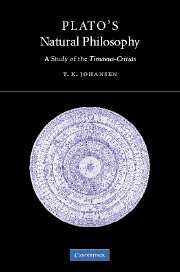Book contents
- Frontmatter
- Contents
- Acknowledgements
- Introduction: Plato's tales of teleology
- 1 What is the Timaeus-Critias about?
- 2 The status of the Atlantis story
- 3 The status of Timaeus' account
- 4 Teleology and craftsmanship
- 5 Necessity and teleology
- 6 Space and motion
- 7 Body, soul, and tripartition
- 8 Perception and cosmology
- 9 Dialogue and dialectic
- Epilogue
- Bibliography
- General index
- Index locorum
8 - Perception and cosmology
Published online by Cambridge University Press: 03 September 2009
- Frontmatter
- Contents
- Acknowledgements
- Introduction: Plato's tales of teleology
- 1 What is the Timaeus-Critias about?
- 2 The status of the Atlantis story
- 3 The status of Timaeus' account
- 4 Teleology and craftsmanship
- 5 Necessity and teleology
- 6 Space and motion
- 7 Body, soul, and tripartition
- 8 Perception and cosmology
- 9 Dialogue and dialectic
- Epilogue
- Bibliography
- General index
- Index locorum
Summary
For Plato [the whole world of sensible things] is an image, not a substance. You cannot, by taking visible things to pieces, ever arrive at any parts more real than the whole you started with. The perfection of microscopic vision can bring you no nearer to the truth, for the truth is not at the further end of your microscope. To find reality you would do better to shut your eyes and think.
I start with Cornford's diagnosis of Plato's view of the perceptible world and perception. Cornford reacted with justification against Taylor's assimilation of Timaeus to a modern positivistic view of science. Taylor had suggested that the status of our accounts of the natural world as merely likely could ultimately be overcome with the progress of empirical science. The Timaeus story was for Taylor a myth only ‘in the sense that it is the nearest approximation which can “provisionally” be made to exact truth’.Cornford was surely right to object that our accounts could in principle only ever be likely in so far as they are accounts of a likeness.
Cornford's and Taylor's positions are contraries but not contradictories. For whilst mutually exclusive, they are not jointly exhaustive. Whilst Taylor gives too much to perception, I want to argue that Cornford gives too little. In natural philosophy perception stands in a complex interactive relationship with reason. It is the aim of this chapter to analyse this relationship.
- Type
- Chapter
- Information
- Plato's Natural PhilosophyA Study of the Timaeus-Critias, pp. 160 - 176Publisher: Cambridge University PressPrint publication year: 2004



